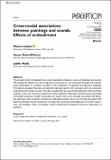Cross-modal associations between paintings and sounds : effects of embodiment
Abstract
The present study investigated cross-modal associations between a series of paintings and sounds. We studied the effects of sound congruency (congruent vs. non-congruent sounds) and embodiment (embodied vs. synthetic sounds) on the evaluation of abstract and figurative paintings. Participants evaluated figurative and abstract paintings paired with congruent and non-congruent embodied and synthetic sounds. They also evaluated the perceived meaningfulness of the paintings, aesthetic value and immersive experience of the paintings. Embodied sounds (sounds associated with bodily sensations, bodily movements and touch) were more strongly associated with figurative paintings, while synthetic sounds (non-embodied sounds) were more strongly associated with abstract paintings. Sound congruency increased the perceived meaningfulness, immersive experience and aesthetic value of paintings. Sound embodiment increased immersive experience of paintings.
Citation
Iosifian , M , Sidoroff-Dorso , A & Wolfe , J 2022 , ' Cross-modal associations between paintings and sounds : effects of embodiment ' , Perception , vol. 51 , no. 12 , pp. 871–888 . https://doi.org/10.1177/03010066221126452
Publication
Perception
Status
Peer reviewed
ISSN
0301-0066Type
Journal article
Description
Funding: This work was supported by the Templeton Religion Trust (grant number TRT0354).Collections
Items in the St Andrews Research Repository are protected by copyright, with all rights reserved, unless otherwise indicated.

